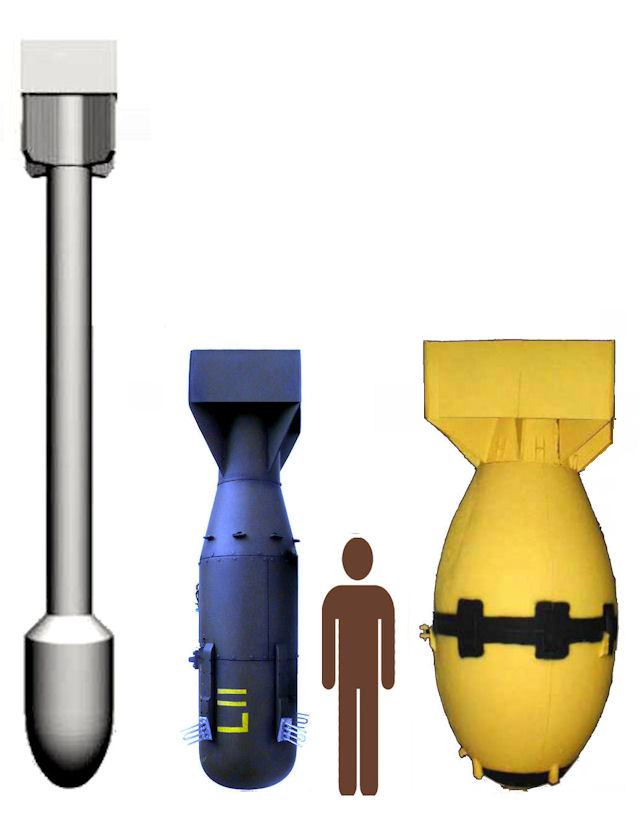Early Bomb Designs
Early work on the design of the atomic bomb began even as scientists continued to arrive at Los Alamos throughout 1943. The properties of uranium were reasonably well understood, those of plutonium less so, and knowledge of fission explosions entirely theoretical. That 2.2 secondary neutrons were produced when uranium-235 fissioned was accepted, but while Glenn Seaborg's team had proven in March 1941 that plutonium underwent neutron-induced fission, it was not known yet if plutonium released secondary neutrons during bombardment.
Further, the exact sizes of the "cross sections" of various fissionable substances had yet to be determined in experiments using the various particle accelerators then being shipped to Los Alamos. The theoretical consensus was that fission chain reactions did take place with sufficient speed to produce powerful releases of energy (and not simply result in the explosion of the chain reaction critical mass itself), but only experiments could test this theory.
The optimum size of the critical mass remained to be established, as did the optimum shape. When enough data were gathered to establish optimum critical mass, optimum effective mass still had to be determined. That is, it was not enough simply to start a chain reaction in a critical mass; it was necessary to start one in a mass that would release the greatest possible amount of energy before it was destroyed in the explosion.
Tall Boy conventional high-explsive bombs were used in 1944 to combat the V-2 rockets from Europe. They were also known as Earthquake Bombs. Over 800 of them were made in the closing stages of WWII. The "Tall Boy" provided some precedent for naming the early atomic bomb designs.
At the beginning of the Manhattan Project, there was one bomb design. That called for using a cannon to assemble a super-critical mass by firing one sub-critical mass into another sub-critical mass. This assembly must happen quickly, or the two masses will pre-detonate as they get closer together, producing a very low yield fizzle, hence the cannon.
By one widely repeated account, the uranium bomb was called Little Boy, and the plutonium version, requiring a longer gun, Tall Man (a reference to FDR). A few sources call the longer gun bomb "Tall Man" - but this is in error.
The standard account relates that "Thin Man," named for President Roosevelt, utilized the plutonium gun design, while "Fat Man", named after Winston Churchill, was an implosion prototype. Emilio Segre's lighter, smaller uranium design became "Little Boy," Thin Man's brother.
Robert Serber was an American physicist who participated in the Manhattan Project. According to his reminiscences (1998), Serber created the names for all three design projects, the "Little Boy" (uranium gun), "Thin Man" (plutonium gun), and "Fat Man" (plutonium implosion). These names were based on their design shapes; the "Thin Man" would be a very long device, the name derived from the Dashiell Hammett detective novel and series of movies of the same name; the "Fat Man" bomb would be round and fat and was named after Sydney Greenstreet's character in The Maltese Falcon (from Hammett's novel). "Little Boy" came last and was named to contrast to the "Thin Man" bomb.
Because the gun-type bomb design seemed so simple and practical, Deke Parsons had assigned implosion studies a low priority and placed the emphasis on the more familiar artillery method. Working with the Army Air Force, Parsons's group developed two bomb models by March 1944 and began testing them with B-29s.
More than a year into the work at Los Alamos, Italian chemist Emilio Segre discovered that the plutonium arriving from Hanford, Washington, was too reactive for even the fastest gun. In April 1944, experiments by Emilio G. Segrè and his P-5 Group at Los Alamos on the newly reactor-produced plutonium from Oak Ridge and the Hanford site showed that it contained impurities in the form of the isotope plutonium-240. By July 1944 it became clear that, because of the plutonium-240 problem, a gun-type design would not work for the plutonium bomb.
The “Crisis of 1944” forced the lab to change direction and focus on implosion. Some sources claim that at this point the term "tall man" was no longer descriptive. So the scientists of Los Alamos gave the gun-design bomb a new code name: Little Boy. This account seems almost entirely spurious. By then there was confidence that if there was enough uranium 235 from Oak Ridge, the Little Boy design would work.
The two atomic bombs being developed in the Manhattan Project were now referred to as Fat Man and Little Boy, abbreviated as the FM model and the LB model. Both types of atomic bombs used against Japan were huge. The “gun-type” Little Boy that was dropped on Hiroshima on 6 August 1945 weighed almost 9,000 lbs., and was 10½ feet in length and 2 feet in diameter. The teardrop-shaped, implosion-type Fat Man that exploded over Nagasaki on 9 August 1945 weighed more than 10,000 lbs. It was only 2 inches longer than Little Boy but, at 5 feet, was much larger in diameter.

|
NEWSLETTER
|
| Join the GlobalSecurity.org mailing list |
|
|
|

